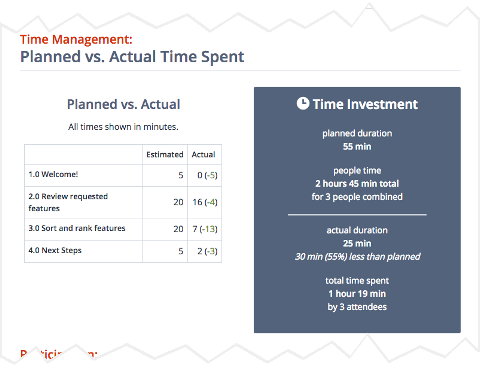The key is in not spending time, but in investing it.
Stephen R. Covey
Before a meeting, this report shows how the meeting leader plans to invest the group's time. After the meeting, the report also shows how the time went.
Calculator
Want to see how time in meetings translates to dollars? Check out the Monthly Organizational Costs Calculator.
Time Management Report Content

The time management section of the meeting report
Time per agenda item
Before the meeting, see at a glance how much time the group plans to spend on each agenda item. If the estimated duration isn't set, you'll see a "--". After the meeting, see how much time that agenda item actually took, and how many minutes less than planned (example: -3) or more than planned (example: +5).
Use this information to improve planning for your next meeting.
Time investment
Before the meeting, you'll see the estimated duration based on the scheduled start and end times. You'll also see the planned investment of people time, which is the total amount of time that will be spent in the meeting if everyone invited attends and the meeting runs the expected time.
Example planned time
Fred scheduled a meeting and invited 7 people.
The planned duration is 50 minutes.
The expected investment of people time for this meeting is:
50 minutes X 7 people = 5 hours 50 minutes
After the meeting, you'll see how long the meeting really lasted, and how much time people actually spent in attendance.
Lucid Meetings calculates total time spent based on data in the automated attendance records.
Example total time spent
Fred's meeting actually lasted 60 minutes.
Only 4 people attended. Fred and Sally all stayed the entire time, but Chris arrived lated and Arnaud had to leave early.
The total time spent was:
60 min (Fred) + 60 min (Sally) + 42 min (Chris) + 45 min (Arnaud) =
3 hours 27 minutes
